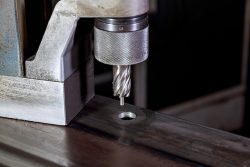How Is HSS Tube Steel Made?
 Hollow Structural Sections (HSS) tube steel is a versatile material used in various industries such as construction, engineering, and manufacturing. It is known for its high strength, durability, and lightweight properties. But have you ever wondered how HSS tube steel is made? In this blog, we will take a closer look at the manufacturing process of HSS tube steel and explore the steps involved in its production.
Hollow Structural Sections (HSS) tube steel is a versatile material used in various industries such as construction, engineering, and manufacturing. It is known for its high strength, durability, and lightweight properties. But have you ever wondered how HSS tube steel is made? In this blog, we will take a closer look at the manufacturing process of HSS tube steel and explore the steps involved in its production.
1. Raw Materials:
The first step in making HSS tube steel is to gather the necessary raw materials. These typically include hot-rolled steel coils and sheets, which are made up of carbon and alloy steel. The steel is sourced from steel mills, where it undergoes rigorous quality checks to ensure its suitability for the production process.
2. Slitting:
Once the steel coils have been selected, they are fed through a machine called a slitter. The slitter cuts the large coils into narrower strips, which are then prepared for the next stage in the process. Slitting is a crucial step as it determines the width and length of the HSS tube steel that will be produced.
3. Forming:
After slitting, the steel strips are formed into the shape of a tube using a roll forming machine. This process involves passing the strips through a series of rollers that gradually bend and shape them into a tubular form. The tightly controlled roll-forming process ensures consistent and accurate dimensions throughout the length of the tube.
4. Welding:
Once the tubes have been formed, they undergo a welding process to create a continuous seam along their length. Various types of welding methods are used, including high-frequency electric resistance welding (ERW), submerged arc welding (SAW), or laser welding. ERW is the most commonly used method in HSS tube steel production, as it offers high efficiency and cost-effectiveness.
5. Heat Treatment:
After welding, the HSS tube steel may undergo a heat treatment process to improve its mechanical properties. Heat treatment involves subjecting the tubes to controlled heating and cooling cycles that can alter their microstructure and enhance their strength and toughness. This step is particularly important for certain applications where high tensile or impact resistance is required.
6. Sizing and Cutting:
The next step in the process is to size and cut the tubes to their desired length. This is usually done using high-precision saws or flying cut-off machines, which ensure clean and accurate cuts. The tubes are carefully measured, and any excess material is removed, resulting in tubes of uniform length and dimensions.
7. Surface Treatment:
To protect the HSS tube steel from corrosion and give it a desired finish, a surface treatment may be applied. This can involve processes such as galvanizing, where a layer of zinc is applied to the surface of the tubes, or painting, where a protective layer of paint is added. These treatments not only enhance the appearance of the tubes but also provide additional durability and resistance against environmental factors.
8. Quality Control:
Throughout the entire manufacturing process, quality control procedures are implemented to ensure that the HSS tube steel meets specific standards and requirements. This includes conducting various tests such as dimensional checks, visual inspections for defects, and mechanical property assessments. Only tubes that pass these rigorous quality tests are approved for delivery to customers.
9. Packaging and Delivery:
Once the HSS tube steel has been manufactured and passed the quality control checks, it is carefully packaged and prepared for delivery. Tubes are bundled together, often with protective end caps, to prevent any damage during transportation. They are then shipped to customers, where they can be used in a wide range of applications, including structural frameworks, automotive components, and furniture manufacturing.
Summary
The production process of HSS tube steel involves several stages, from sourcing the raw materials to delivering the finished product. Each step is crucial in ensuring the high quality, strength, and durability of the tubes. By understanding how HSS tube steel is made, we can appreciate the complexity and precision involved in creating this versatile and essential material.
Need Engineers and Designers in Hudson, CO?
Since 2006, High Plains Engineering & Consulting, LLC has been a civil and structural engineering company in Fort Lupton and the surrounding areas. We provide sensible solutions to geotechnical, structural, environmental, and civil engineering challenges. Our office provides practical expertise backed by diverse design resources to get the job done cost-effectively and efficiently with sustainability in mind. We offer various services for commercial, residential, and agricultural properties like soil testing, percolation testing, and foundation and septic design for new construction. Once that is taken care of we also offer services for floor framing, garage plans, house plans, site plans, and inspection services. Call us today for an appointment!
Categorised in: HSS Tube Steel

 HPEC is an active member of CAGE
HPEC is an active member of CAGE